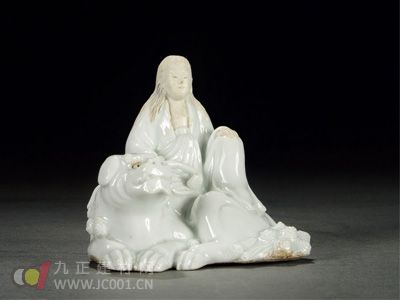Identification Method of Green and White Porcelain: First, examine the glaze surface. The craftsmanship of Qingbai porcelain during the Song Dynasty was pioneered by the Hutian Kiln. Therefore, many modern workshops use this as their "standard model." They try to achieve a white glaze with a bluish tint, resembling jade, but often overdo it, resulting in an unnatural appearance. The Qingbai porcelain from the Song Dynasty is a high-calcium glaze porcelain, with calcium oxide content reaching up to 14%. When fired at around 1300°C, the glaze becomes very fluid. As a result, areas such as the raised patterns, edges, and curves of the vessels tend to have thicker glaze, appearing lake-blue with small, foam-like bubbles. The glazed areas are white and shiny, giving a soft luster. Most imitations use lime-alkali glazes with lower calcium oxide content, which have less fluidity at high temperatures. This leads to fewer distinct glaze characteristics. The overall glaze color tends to be uniform, and the surface appears matte or slightly devitrified. Some imitations even apply artificial glaze on specific areas like the edges or corners, making the glaze thicker and darker. However, these artificial glazes lack the natural, bubble-like texture found in authentic pieces. Instead, they look flat and blocky. Some fakes have overly bright surfaces that lack the subtle sheen of ancient pieces, known as "Baoguang." Others use acid etching to dull the surface, but this often results in an unnatural, heavy look. With careful observation, these flaws become obvious. Second, check the quality of the body (fetus). Many books describe the body of Song-era Qingbai porcelain as white and firm, with a high degree of vitrification. While this is true relative to the technology of the time, it's not comparable to today's porcelain. Modern porcelain is much finer and more refined. The actual body of Song-era Hutian Kiln Qingbai porcelain had a light brownish or grayish tone. At that time, there was no binary formula of porcelain stone and kaolin (introduced later in the Yuan Dynasty), so the body wasn't as strong as modern porcelain. You can see this clearly when looking at the cross-section of fragments—fine pores are visible. Additionally, the clay used back then wasn’t ground as finely as today’s materials. Many authentic pieces show small slag particles, especially on the bottom. Modern imitations, however, have smooth, white, and strong bodies, making them easy to distinguish. Some workshops try to mimic the old look by mixing colored soil or fine sand into the clay, altering its color and structure. Others paint the exposed areas with loess or black mud to simulate aging. These tricks can usually be spotted with a bit of common sense. Third, inspect the foot. From historical artifacts and excavated pieces, Song-era Qingbai porcelain typically used three methods for the foot: covering the mouth (Mangkou), stacking rings, or firing on a cake. Contemporary imitations often copy the first two, but with knowledge of the original body quality, it's not hard to tell them apart. The third method—firing on a cake—is trickier because few people understand it well. It's important to note that real cake marks are faint khaki or brownish yellow, with varying shades. Imitations, on the other hand, are not actually fired on cakes. Instead, they're fired in gas kilns and then painted with artificial glaze, pigments, or other substances to create fake cake marks. These marks appear too dark, deep, and uniform, lacking the natural variation of real ones. Some imitations simply coat the bottom with yellow water or mud to create a "cake mark," which looks artificial and unconvincing. Also, some pieces have unglazed feet with full glaze on the body, or both cake and nail marks, which don’t align with traditional kiln techniques. Such inconsistencies are clear signs of fakes. Fourth, study the shape. Since green and white porcelain was produced across many kilns over a long period, the variety of forms is vast. From daily-use items to ritual objects, the diversity is immense. To identify genuine pieces, one must understand the basic shapes and how they evolved over different periods. Most modern imitations are based on official publications or preserved examples, making them relatively easy to spot with some knowledge. However, some replicas are more convincing and can easily fool the untrained eye. It's crucial to pay close attention and develop a good understanding of the historical context and craftsmanship of Qingbai porcelain. Compression Spring,Irregular Compression Spring,Customized Compression Springs,Compression Spring Processing Dongguan Jiufukai Hardware Products Co., Ltd , https://www.jfkspring.com